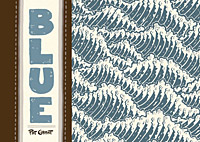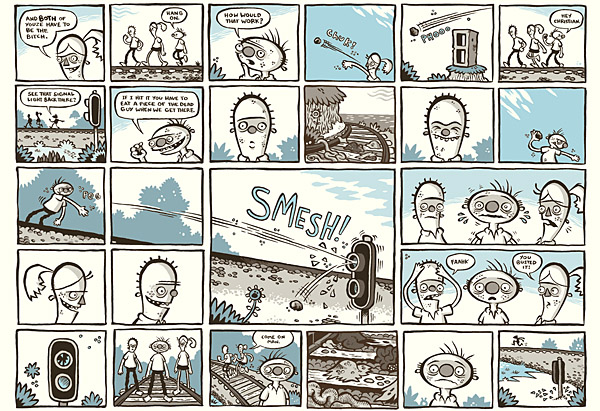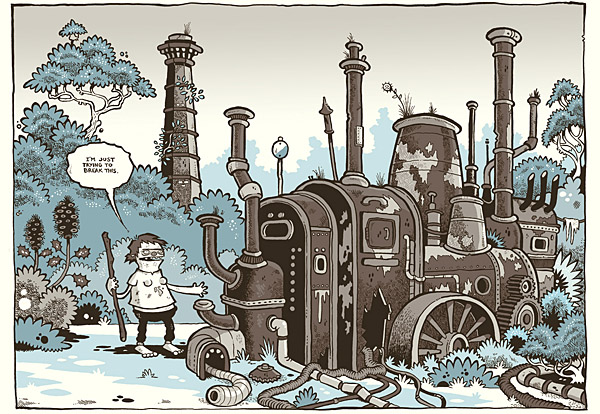 By Pat Grant
By Pat Grant
96 pages, color
Published by Top Shelf Productions
I’d never heard of Australian cartoonist Pat Grant before Blue, but in a matter of pages I found myself deeply impressed by the creator. In his graphic novel, Grant does more than just tell a story about three teens on a local adventure; he brings a story together in a way that can be read with as much or as little allegory as you want and still have it provide a punch, and in a way that immerses you in the Australian culture of Grant’s youth that ends up dropping you in, wholesale.
In an afterward/essay, Grant admits that there’s a certain similarity between one of the main ideas of Blue and Stephen King’s novella “The Body” (which was turned into the film Stand By Me). After all, in Blue the three main characters of Christian, Verne, and Muck decide to head out and see a dead body on the tracks that was hit by a train. In the case of Blue, though, there are two things to keep in mind. First, Blue is based on an actual experience of Grant’s as a teen of going to see a dead body in the same situation; and second, that Blue has a lot more packed into its pages than just a hunt for a body.

I think the element of Blue that grabbed me the most was the usage of the the blue-skinned, tentacled aliens that are arriving in the town of Bolton. Issues of immigration are just as contentious in Australia as other parts of the world, these days, and Grant’s “blue people” can certainly be seen as an allegory for any group of people that look outwardly as different than the locals. There’s something instantly touching about the first scene that introduces the blue aliens, as they pause to dress in a way to try and blend in, and slowly move through Bolton performing generic events in everyday life. It doesn’t matter if you view them as actual aliens or merely people from another country; the more you get to know about the blue people, the more it’s hard to keep from feeling bad for them. Grant gives them a strong visual, too; not just in their appearance, but by their graffiti/scrawl/tags that they leave on the walls. They look almost like hieroglyphics, packed in tightly in a way that lets you decode their meaning when you look closely, but becomes an overwhelming buzz of static as you take in more and more of it in a single glance.
The main characters are interesting in that Grant doesn’t go the easy route of making Christian a particularly wonderful person. He and his friends are, after all, skipping school and more than a touch of hoodlum. We get an introduction to them that comes across as spiteful and bullyish; it’s not until a few pages later that you realize that they’re not the villains but in fact the protagonists. With Blue being told in flashback by Christian, Grant also lets us see early on the kind of person he turns into, and he’s not terribly pleasant. More than a touch xenophobic, it seems hard at first to find yourself able to warm to this sort of character. And yet, that’s part of the strength of Blue. Christian and friends might not be the brightest or most pleasant of characters, but they’re compelling. The more we see them wander through town and up the tracks, the more Grant drags you into their small world. From the childish taunts to the destructive games that they clearly don’t think all the way through (until it’s too late), these are pitch-perfect depictions of teenagers. And even though we know how Christian’s life is going to end up, it’s hard to keep from hoping that somehow, impossibly, they’ll shape up. When we get to the climax of Blue, it’s a surprisingly gripping and emotional moment; the fear and hesitation there really leaps off the page and grabs you as a reader.

Blue‘s art is great, a slightly devolved, cartoonish style that reminds me of artists like Dave Cooper and Patrick McEown. Their faces and features are simple, but their over-the-top nature hides a bit of expression that grows on you with time. They’re comical to look at, even as there’s an edge of steel to their creation. But even as you marvel at his oblong, distended characters, don’t let it distract you from the backgrounds, or the page layouts. Grant fires on all cylinders there; the rock that Muck throws arcing through several panels in a 6×5 layout, or the resulting sprint down the train line even as trees and buildings alike sprout up all around them. The amount of detail in something as simple as an abandoned (and wisely, never truly explained) machine is great; it feels alien and dangerous at a glance, even as you want to get closer and focus more on it while the story moves on. Something as simple as a pattern of waves is hypnotic in nature, thanks to Grant.
Blue is a great introduction to Grant as a comic creator, and if that isn’t enough there’s a strong and informative essay about both Grant’s life growing up as well as the Australian surf comic scene, something I’d never heard of before (but which appears briefly in Blue). Blue is scheduled for a March 2012 release, and trust me when I say that it’s a winner. Blue is a strong, focused graphic novel that is bound to impress.
Purchase Links: Amazon.com | Powell’s Books

One Reply to “Blue”
Comments are closed.